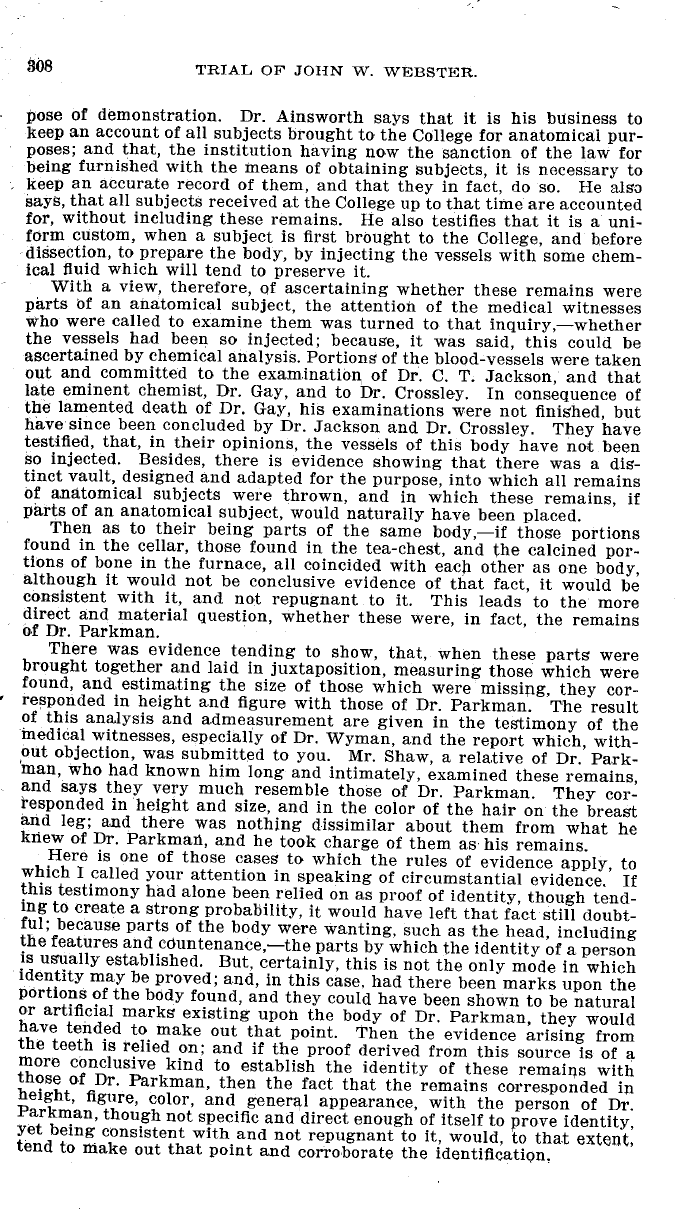|
808 TRIAL OF JOHN W. WEBSTER.
pose of demonstration. Dr. Ainsworth says that it is his business to
keep an account of all subjects brought to the College for anatomical pur-
poses; and that, the institution having now the sanction of the law for
being furnished with the means of obtaining subjects, it is necessary to
keep an accurate record of them, and that they in fact, do so. He also
says, that all subjects received at the College up to that time are
accounted
for, without including these remains. He also testifies that it is a uni-
form custom, when a subject is first brought to the College, and before
dissection, to prepare the body, by injecting the vessels with some chem-
ical fluid which will tend to preserve it.
With a view, therefore, of ascertaining whether these remains were
parts of an anatomical subject, the attention of the medical witnesses
who were called to examine them was turned to that inquiry,-whether
the vessels had been so injected; because, it was said, this could be
ascertained by chemical analysis. Portions of the blood-vessels were taken
out and committed to the examination of Dr. C. T. Jackson, and that
late eminent chemist Dr. Gay, and to Dr. Crossley. In consequence of
the lamented death of Dr. Gay, his examinations were not finished, but
have since been concluded by Dr. Jackson and Dr. Crossley. They have
testified that in their opinions, the vessels of this body have not been
so injected. Besides, there is evidence showing that there was a dis-
tinct vault, designed and adapted for the purpose, into which all remains
of anatomical subjects were thrown, and in which these remains, if
parts of an anatomical subject, would naturally have been placed.
Then as to their being parts of the same body,-if those portions
found in the cellar, those found in the tea-chest, and the calcined por-
tions of bone in the furnace, all coincided with each other as one body,
although it would not be conclusive evidence of that fact, it would be
consistent with it, and not repugnant to it. This leads to the more
direct and material question, whether these were, in fact, the remains
of Dr. Parkman.
There was evidence tending to show, that, when these parts were
brought together and laid in juxtaposition, measuring those which were
found, and estimating the size of those which were missing, they cor-
responded in height and figure with those of Dr. Parkman. The result
of this analysis and admeasurement are given in the testimony of the
medical witnesses, especially of Dr. Wyman, and the report which, with-
out objection was submitted to you. Mr. Shaw, a relative of Dr. Park-
man, who who had known him long and intimately, examined these remains,
and says they very much resemble those of Dr. Parkman. They cor-
responded in height and size, and in the color of the hair on the breast
and leg; and there was nothing dissimilar about them from what he
knew of Dr. Parkman, and he took charge of them as his remains.
Here is one of those cases to which the rules of evidence apply, to
which I called your attention in speaking of circumstantial evidence. If
this testimony had alone been relied on as proof of identity, though tend-
ing to create a strong probability, it would have left that fact still
doubt-
ful; because parts of the body were wanting, such as the head, including
the features and countenance,-the parts by which the identity of a person
is usually established. But certainly, this is not the only mode in which
identity may be proved; and, in this case, had there been marks upon the
portions of the body found, and they could have been shown to be natural
or artificial marks existing upon the body of Dr. Parkman, they would
have tended to make out that point. Then the evidence arising from
the teeth is relied on; and if the proof derived from this source is of a
more conclusive kind to establish the identity of these remains with
those of Dr. Parkman, then the fact that the remains corresponded in
height, figure, color, and general appearance, with the person of Dr.
Parkman, though not specific and direct enough of itself to prove identity,
yet being consistent with and not repugnant to it, would, to that extent,
tend to Make out that point and corroborate the identification.
|

